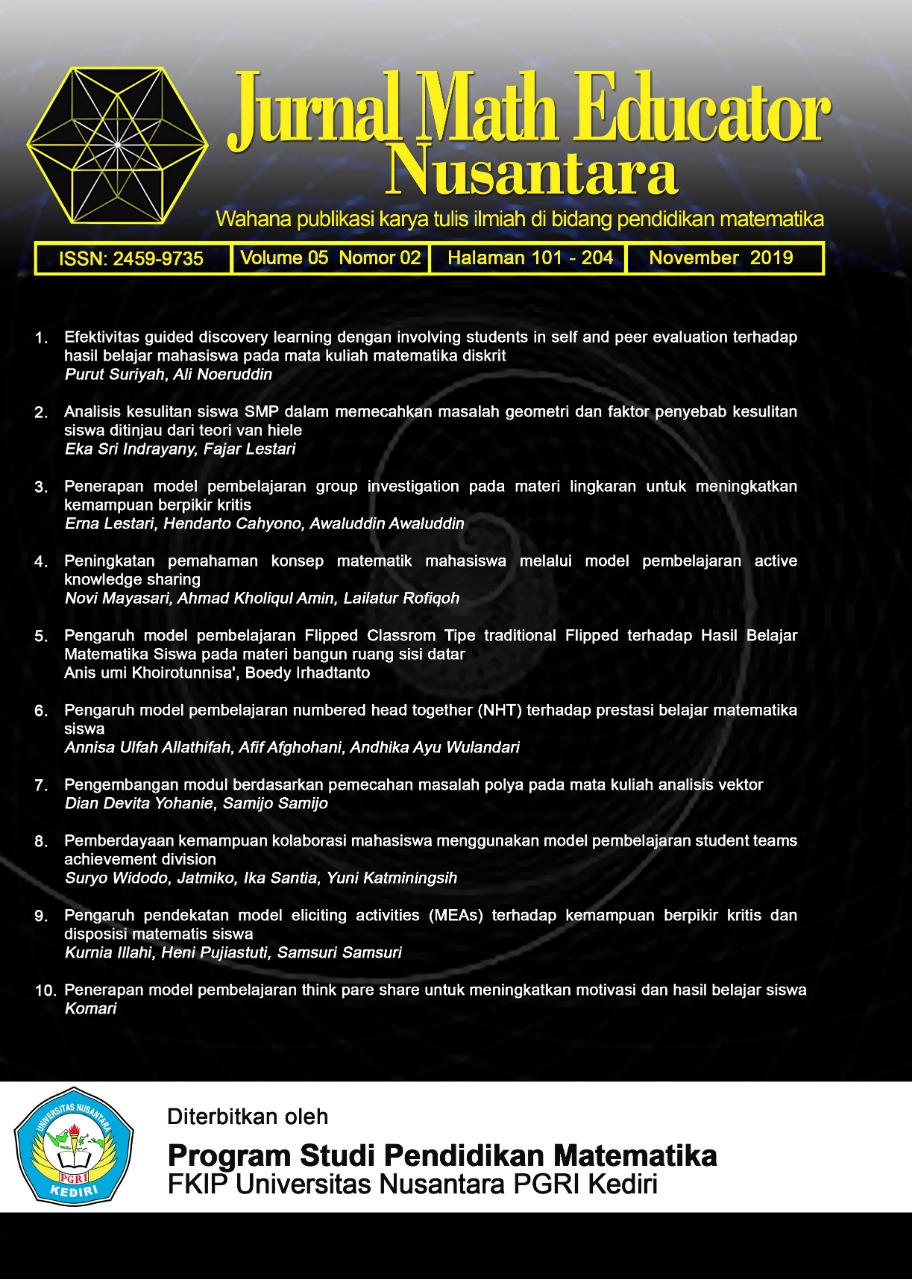Pemberdayaan kemampuan kolaborasi mahasiswa menggunakan model pembelajaran student teams achievement division
DOI:
https://doi.org/10.29407/jmen.v5i2.13795Keywords:
kolaborasi, mahasiswa, pemberdayaan, Student Teams Achiievement Division, model pembelajaran, Lesson Study, PTKAbstract
Tujuan penelitian ini adalah untuk meningkatkan kemampuan kolaborasi mahasiswa program studi pendidikan matematika Universitas Nusantara PGRI Kediri menggunakan model pembelajaran Student Teams Achiievement Division (STAD) melalui penelitian tindakan kelas yang dikolaborasikan dengan Lesson Study yang mempunyai 3 tahapan yaitu pland, do, dan see. Penelitian terdiri dari 2 siklus, yang setiap siklus terdiri dari 4 pertemuan. Upaya yang dilakukan dosen model berhasil meningkatkan kemampuan kolaborasi mahasiswa dengan menggunakan model pembelajaran Student Teams Achiievement Division. Hasil ditunjukan dari peningkatan presentase pada kemampuan kolaborasi mahasiswa dari 73,67% pada siklus I menjadi 78,17% pada siklus II
References
Arikunto, Suharsimi. (2009). Prosedur Penelitian Suatu Pendekatan Praktik Edisi Revisi 6. Jakarta: Rineka Cipta
Darmawan, Ragil. (2018). Penerapan kurikulum 2013 untuk meningkatkan kemampuan kolaborasi, hasil belajar dan respon siswa kelas X TKR 1 pada mata pelajaran pekerjaan dasar teknik otomotif di SMKN 1 Kalianget. JPTM, 6(3), 53-58
Fauzi, Ahmad. (2015). Manajemen Pembelajaran (edisi revisi). Yogyakarta: K-Media
Greenstein, L. (2012). Assessing 21st Century Skill: A Guide to Evaluating Mastery and Authentic Learning. United States of America: Corwin A Sage Company.
Haryati, P.S., Yudana, M., & Candiasa, I. M. (2013). Pengaruh Penerapan Model Pembelajaran Kooperatif tipe Student Teams Archievement Division (STAD) Berbasis Asesmen Kinerja terhadap Prestasi Belajar Matematika Ditinjau dari Bakat Numeric pada Siswa Kelas X SMKN 3 Singaraja. Jurnal Penelitian dan Evaluasi Pendidikan Singaraja: Universitas Pendidikan Ganesha 3 (1).pp.1-10
Lee, Huh, Reigeluth. (2015). Collaboration, intragroup conflict, and social skills in project-based learning. Instructional science. Volume 43, Issue 5, pp 561–590. Springer.
Majid, Abdul. (2013). Strategi Pembelajaran. Bandung: PT. Remaja Rosdakarya.
McDowell, C., Werner, L., Bullock, H. & Fernald, J. (2002). The Effect of Pair Programming on Performance in an Introductory Programming Course dalam ACM Special Interest Group of Computer Science Educators, pp.38-42.
Nagappan, N., Williams, L., Ferzli, M., Yang, K., Wiebe, E., Miller, C., & Balik, S. (2003). "Improving the CS1 Experience with Pair Programming" dalam SIG CSE 2003, 359-362.
Nurhadi. (2004). Pembelajaran Kontekstual dan Penerapannya dalam KBK, Malang: UMM Press.
Nurlizawati. (2019). Penerapan Model Pembelajaran Tutor Teman Sebaya Di Sman 1 Pasaman. Jurnal Socius: Journal of Sociology Research and Education, 6(1),33-41 DOI: https://doi.org/10.24036/scs.v6i1.127
Partnership for 21st Century Learning. (2015). P21 Framework Definition. Retrieved September 10, 2019, from http://www.p21.org/our-work/p21- framework/P21 _Framework_Definitions_New_Logo2015.pdf
Rahayu. (2003). Konsep Strategi Pembelajaran. Bandung: Refika aditama
Rohman, Arif. (2013). Model pembelajaran inter-teams game tournament untuk pengembangan kemampuan kolaborasi mahasiswa calon guru. Jurnal Penelitian Ilmu Pendidikan, 6(1), 1-10
Nilson, Sarah. (2019). Collaborative Learning. (tersedia di http://www.sarahnilsson.org/ learn/collaborative-learning/)
Suyanto, (2009). Olimpiade Sains Nasional 2009 Ajang Unjuk Prestasi Siswa Indonesia. Jakarta: Departemen Pendidikan Nasional.
Williams, L., Wiebe, E., Yang, K., Ferzli, M., & Miller, C. (2002). In Support of Pair Programming in the Introductory Computer Science Course dalam Computer Science Education, 12, 3, 197-212.
Yusron, N. (2005). Model-Model Pembelajaran. Jakarta: PT Raja Grafindo Persada.
Downloads
Published
Issue
Section
License
Authors who publish with this journal agree to the following terms:
- Copyright on any article is retained by the author(s).
- The author grants the journal, the right of first publication with the work simultaneously licensed under a Creative Commons Attribution License that allows others to share the work with an acknowledgment of the work’s authorship and initial publication in this journal.
- Authors are able to enter into separate, additional contractual arrangements for the non-exclusive distribution of the journal’s published version of the work (e.g., post it to an institutional repository or publish it in a book), with an acknowledgment of its initial publication in this journal.
- Authors are permitted and encouraged to post their work online (e.g., in institutional repositories or on their website) prior to and during the submission process, as it can lead to productive exchanges, as well as earlier and greater citation of published work.
- The article and any associated published material is distributed under the Creative Commons Attribution-ShareAlike 4.0 International License
















